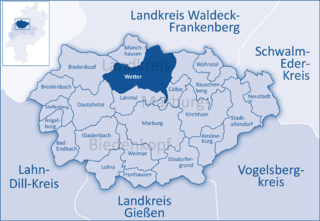Lahn-Dill is a Kreis (district) in the west of Hesse, Germany. Neighboring districts are Siegen-Wittgenstein, Marburg-Biedenkopf, Gießen, Wetteraukreis, Hochtaunuskreis, Limburg-Weilburg, Westerwaldkreis.
Marburg-Biedenkopf is a Kreis (district) in the west of Hesse, Germany. Neighboring districts are Waldeck-Frankenberg, Schwalm-Eder, Vogelsbergkreis, Gießen, Lahn-Dill, Siegen-Wittgenstein.

Wetter (Hessen) is a small town in Hesse, Germany. The rather unusual designation Wetter (Hessen-Nassau) stems from a time when the town belonged to the Prussian province of the same name, and nowadays is only used by the railway – even today, the railway station in town bears this name.

Hatzfeld (Eder) is a small town in Waldeck-Frankenberg district in Hesse, Germany.

Dautphetal is a community in Hesse, Germany, and is among the six larger communities of the 22 in Marburg-Biedenkopf district.

The community of Lahntal is found in the Marburg-Biedenkopf district in northwest Middle Hesse, Germany.

Leun is a small town in the Lahn-Dill-Kreis in Hesse, Germany.

Eschenburg is a community in the Lahn-Dill-Kreis in Hesse, Germany. The community inherited its name from nearby Eschenburg mountain.

Amöneburg is a town in the Marburg-Biedenkopf district in Hesse, Germany. It lies on a mountain and is built around the castle of the same name, Burg Amöneburg.

Angelburg is a community in western Marburg-Biedenkopf in northwest Middle Hesse in Germany.

Biedenkopf is a spa town in western Hesse, Germany with a population of 13,588.

Breidenbach is a community in the west of Marburg-Biedenkopf district in Hesse, Germany.

Ebsdorfergrund is a community consisting of eleven villages in the southeast of Marburg-Biedenkopf district in Hesse, Germany.

Weimar is a community in the south of Marburg-Biedenkopf district in Gießen administrative region, Hesse, Germany. The community's administrative seat is the centre of Niederweimar.

Gladenbach [German pronunciation: [ˈɡlaːdn̩ˌbax](listen)] is a town in Hesse, Germany, in the west of Marburg-Biedenkopf district.

Cölbe is a community in Marburg-Biedenkopf district in Hesse, Germany.

Steffenberg is a community in Marburg-Biedenkopf district in Hesse, Germany.

Bischoffen is a community in the Lahn-Dill-Kreis in Hesse, Germany.

Burgwald is a community in Waldeck-Frankenberg in Hesse, Germany.

The land known as the Hessian Hinterland lies within the region of Middle Hesse and is concentrated around the old county of Biedenkopf, that is the western part of the present county of Marburg-Biedenkopf, as well as elements of the present-day counties of Lahn-Dill-Kreis and Waldeck-Frankenberg. Formerly it snaked its way from Bromskirchen in the north to Rodheim, in the municipality of Biebertal.
























